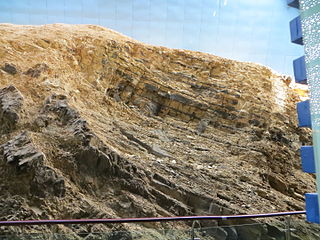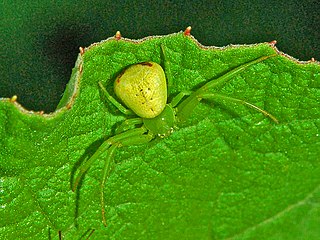
The Maotianshan Shales (帽天山页岩) are a series of Early Cambrian sedimentary deposits in the Chiungchussu Formation, famous for their Konservat Lagerstätten, deposits known for the exceptional preservation of fossilized organisms or traces. The Maotianshan Shales form one of some forty Cambrian fossil locations worldwide exhibiting exquisite preservation of rarely preserved, non-mineralized soft tissue, comparable to the fossils of the Burgess Shale of British Columbia, Canada. They take their name from Maotianshan Hill in Chengjiang County, Yunnan Province, China.
Myllokunmingia is a genus of basal chordate from the Lower Cambrian Maotianshan shales of China 518 mya and is thought to be a vertebrate, although this is not conclusively proven. The species M. fengjiaoa is 28 mm long and 6 mm high. It is among the oldest possible craniates, found in the lower Cambrian Chengjiang. It appears to have a skull and skeletal structures made of cartilage. There is no sign of biomineralization of the skeletal elements. The holotype was found in the Yuanshan member of the Qiongzhusi Formation in the Eoredlichia Zone near Haikou at Ercaicun, Kunming City, Yunnan, China. Only one species is known – Myllokunmingia fengjiaoa. Related creatures are Haikouichthys and Zhongjianichthys.

Cathaymyrus is a genus of Early Cambrian chordate known from the Chengjiang biota in Yunnan Province, China. Both species have a long segmented body with no distinctive head. The segments resemble the v-shaped muscle blocks found in cephalochordates such as Amphioxus. A long linear impression runs along the "back" of the body looking something like a chordate notochord.
Sinocyclocheilus is a genus of freshwater fish in the family Cyprinidae that is endemic to Guangxi, Guizhou and Yunnan in China. Almost all of its species live in or around caves and most of these have adaptions typical of cavefish such as a lack of scales, lack of pigmentation and reduced eyes. Several species have an unusual hunchbacked appearance and some of the cave-dwellers have a "horn" on the back, the function of which is unclear. In contrast, the Sinocyclocheilus species that live aboveground, as well as a few found underground, show no clear cavefish adaptions. They are relatively small fish reaching up to 23 cm (9.1 in) in length. The individual species have small ranges and populations, leading to the status of most of the evaluated species as threatened. Many species populations in the genus have yet to be evaluated by the IUCN.

Schistura is a genus of fish in the stone loach family Nemacheilidae native to the streams and rivers of the southern and eastern Asia. Some of these species are troglobitic.

Triplophysa is a genus of fish in the family Nemacheilidae found mainly in and around the Qinghai-Tibet Plateau in China, as well as inland waters of the larger part of central Asia. They can be distinguished from other genera of Nemacheilidae by marked sexual dimorphism, including the development of nuptial tubercles on breeding males. Currently, the genus is a mixed assemblage of species. Some lineages have been identified and treated as subgenera, but as Wikipedia follows Fishbase for fish species all but Hedinichthys have been treated as subgenera in Wikipedia, although Kottelat in his revision of the loaches did recognise them as valid. FishBase, however, includes these in Triplophysa without specifying subgenera and treats the names given by Kottelat as synonyms.

Yunnanilus is a genus of small stone loaches that are endemic to southeastern China, especially Guangxi and Yunnan. They are found in rivers, streams and lakes; some species are restricted to caves.
Cāng zhú, also known as black atractylodes rhizome or Rhizoma Atractylodes, is a Chinese herbal medicine. It is the dried rhizome of Atractylodes lancea (Thunb.) DC., synonyms Atractylodes chinensis (DC.) Koidz, and Atractylodes japonica Koidz. The medicine is distinguished from bái zhú, which is typically cultivated, whereas cāng zhú more often tends to be collected from the wild. It is believed that the distinction between cāng zhú and bái zhú emerged in relatively modern times; a single drug "zhú" described in the Shen nong ben cao jing probably included many Atractylodes species.

Pestalotiopsis is a genus of ascomycete fungi in the Sporocadaceae family.
Homatula is a genus of stone loaches endemic to China.
Fengyangshan-Baishanzu National Nature Reserve is a nature reserve in southwest Zhejiang province of eastern China. The reserve lies within Longquan and Qingyuan counties. The highest peak of Zhejiang, Huangmaojian, is located within the reserve. The present reserve was formed in 1992 by merging two provincial-level nature reserves, Fengyang Shan Nature Reserve and the Baishanzu Nature Reserve (1985).

Li Jiayang is a Chinese agronomist and geneticist. He is Vice Minister of Agriculture in China and President of the Chinese Academy of Agricultural Sciences (CAAS). He is also Professor and Principal investigator at the Institute of Genetics and Development at the Chinese Academy of Sciences (CAS).
Nanningia is a monotypic genus of Chinese long-jawed orb-weavers containing the single species, Nanningia zhangi. It was first described by M. S. Zhu, J. P. Kim & D. X. Song in 1997, and has only been found in China.
Alenatea is a genus of Asian orb-weaver spiders first described by D. X. Song, Ming-Sheng Zhu & J. Chen in 1999. As of April 2019 it contains only three species.
Takayus is a genus of Asian comb-footed spiders that was first described by H. Yoshida in 2001.
Karstia is a genus of Asian ray spiders that was first described by H. M. Chen in 2010.

Ebrechtella is a genus of crab spiders that was first described by Friedrich Dahl in 1907.
Troglocoelotes is a genus of east Asian funnel weavers. It was first described by B. Li, Z. Zhao and C. T. Zhang in 2019, and it has only been found in China.
Kang Zhang is a Chinese-American ophthalmologist specializing in ophthalmic genetics and aging processes in the eye. He is currently a Professor of the Faculty of Medicine at Macau University of Science and Technology. He was previously a Professor of Ophthalmology and the Founding Director of the Institute for Genomic Medicine at the University of California, San Diego. Zhang is particularly known for his work on lanosterol, stem cell research, gene editing, and artificial intelligence.

Severe acute respiratory syndrome coronavirus 2 (SARS‑CoV‑2) is a strain of coronavirus that causes COVID-19, the respiratory illness responsible for the COVID-19 pandemic. The virus previously had the provisional name 2019 novel coronavirus (2019-nCoV), and has also been called human coronavirus 2019. First identified in the city of Wuhan, Hubei, China, the World Health Organization designated the outbreak a public health emergency of international concern from January 30, 2020, to May 5, 2023. SARS‑CoV‑2 is a positive-sense single-stranded RNA virus that is contagious in humans.








